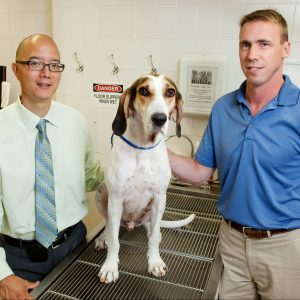Procaspase-activating compound, or PAC-1, is an anticancer drug discovered in chemistry professor Paul J. Hergenrother’s laboratory and further developed with the assistance of Timothy Fan, a professor of veterinary clinical medicine. While PAC-1 is currently being used to treat late-stage cancer patients in clinical trials, its initial promise was recognized when it was used to successfully treat pet dogs suffering from cancer.
This pathway of drug development, through treatment of pets with spontaneous cancer, is highly unusual and requires close collaboration between the basic and applied sciences. PAC-1 is believed to be one of the very few cancer drugs to be first extensively evaluated in pets with cancer. A more traditional path is to implant cancer into mice and treat them with the drug.

PAC-1 was discovered in the early 2000s during a series of experiments in the Hergenrother lab whereby more than 20,000 compounds were assessed for their ability to turn on an enzyme that selectively kills cancer cells. As many of the cancers that afflict dogs are very similar to their human counterparts, PAC-1 and related compounds have been assessed in pet dogs with lymphoma, glioma, meningioma, and metastatic osteosarcoma.
One of the star patients to take PAC-1 was Pretzel, a small dachshund with a brain tumor, who experienced tumor shrinkage and lived long past her life-expectancy after treatment with PAC-1 in combination with a standard-of-care cancer drug. One of the unusual traits of PAC-1 is its ability to penetrate the blood-brain barrier, a natural shield that keeps most drugs out of the brain and thus makes many forms of brain cancer incurable.

In 2011 Vanquish Oncology was founded to advance PAC-1 for treatment of human cancer patients. As of 2019 clinical trials of PAC-1 were on-going in late-stage cancer patients, and separate clinical trials being conducted using PAC-1 in patients with recurrent brain cancer and recurrent kidney cancer.
More generally, PAC-1 has served as a blueprint for other anticancer compounds being developed at the University of Illinois Urbana-Champaign. The Anticancer Discovery from Pets to People research theme at the Institute for Genomic Biology has focused on the compassionate treatment of pets with cancer as a means to help animals with few other options, while simultaneously advancing drugs for human cancer patients.
– Institute for Genomic Biology – This research is part of the IGB theme Anticancer Discovery from Pets to People
– Roger Adam’s Laboratory – Where research on enzymes was conducted by Dr. Hergenrother’s team.
– Veterinary Teaching Hospital – Where the trials on dogs took place with Dr. Fan
Pretzel’s use of PAC-1: https://illinoisalumni.org/2018/02/20/saving-pretzel/
Institute for Genomic Biology theme: https://www.igb.illinois.edu/research-areas/anticancer-discovery-pets-people
PAC-1 Wikipedia page: https://en.wikipedia.org/wiki/PAC-1
